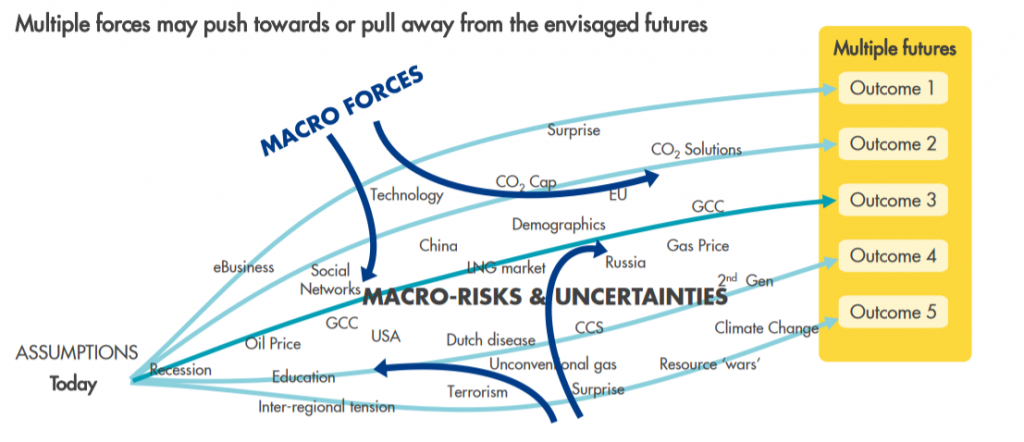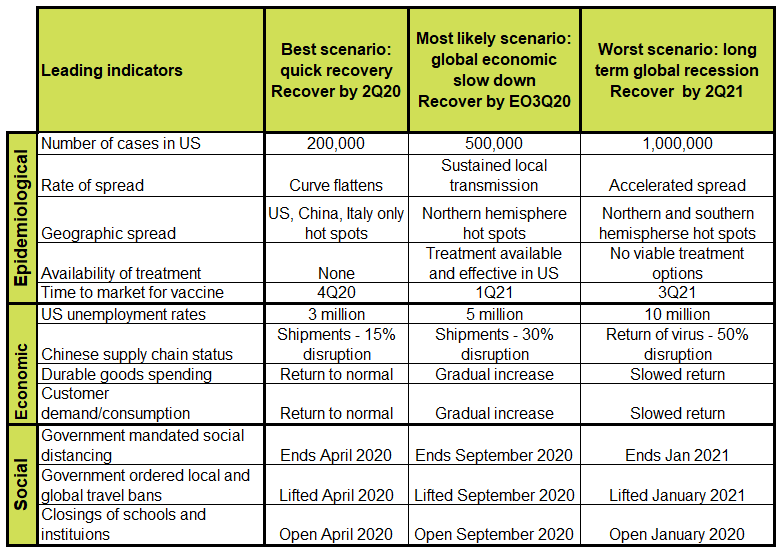Strategic scenario risk planning techniques help anticipate possible futures under conditions of uncertainty like Coronavirus
 Many bosses and employees have been through economic crises before, such as the last financial crisis of 2008. They know that each time the agony is different—and that each time some entrepreneurs and firms will adapt and bounce back.
Many bosses and employees have been through economic crises before, such as the last financial crisis of 2008. They know that each time the agony is different—and that each time some entrepreneurs and firms will adapt and bounce back.
With the US now being more than a month into the Coronavirus driven turmoil that has been spreading across the country, CEOs and business leaders must focus on the “now” to protect the health and safety of their employees, customers, suppliers and other stakeholders while beginning to plan for a new “tomorrow”. A recent article in the Economist titled “the coronavirus crisis will change the world of commerce” wrote “the current shock wave ripping through the business world is daunting. With countries accounting for over 50% of world GDP in lockdown, the collapse in commercial activity is far more severe than in previous recessions.”
With the risks and uncertainty about when the curve will start to flatten and peek, as well as the near and long term future of getting the economy restarted, the only thing constant is the fluctuation of change. The exit path from lockdowns will be a precarious one, (while many state Governers are starting talk about ‘when and how’) with consumer un ease, a stop-start rhythm that inhibits efficiency, and unclear new health and measurement protocols such as the proposed contact tracing etc.

So for companies who are looking to navigate their near, medium and long term business goals, protecting the value of the enterprise will be of upmost importance as well as rethinking plans on how to enhance value in this “new normal” post crisis environment.Taking the pulse of your customers, thinking through longer-term considerations around shifts in core markets or business models as a result of the outbreak.
Here is where strategic scenario planning should fit into your company’s response to the Coronavirus:
- Protect health and safety
- Financial resiliency
- Strategic scenario planning
- New normal strategy
It goes without saying that the foremost priority is the health, safety and well-being of your company’s stakeholders. As of mid March, most businesses have addressed these concerns of social distancing of shelter in place and are now moving quickly to create a remote work environment or maintain safe facilities.
As the economy continues to slow down the public health crisis of the Coronavirus, the next priority for businesses is to understand their cash position and working capital needs — especially if there is a need to recapitalize the business. In my last article I recommended that companies need to set up short-term cash flow forecast and run multiple scenarios that can show a detailed view of cash inflows, outflows and the ability to meet financial obligations as they come due. Cash flow forecasting models and scenarios van enable management, lenders and investors to make decisions impacting immediate and near term cash flows. According to data from the Economist article “many corporations have only enough inventories and cash to survive for three to six months. As a result they have started to fire or idle workers.”
Businesses will need to find a way to stabilize their financial position and start to revisit their current strategic plans. Unfortunately many management teams have developed a number of strategies over the last 10 year economic expansion cycle on a set of assumptions that could include:
- sustained economic growth
- tight labor markets
- the availability of capital
- and other market factors that have been consistent in recent years.
It is not an foolish to suggest that the assumptions a company makes during good times may need to change or be thrown out during rough times. Your business strategy should be adapted quickly and include a new set of assumptions that take into account the current macroeconomic environment that our country and world is now facing.
No economist has a crystal ball in predicting what exactly is going to happen next, but it might be a smart decision to run through a few strategic scenarios based on informed assumptions and a set of go-forward of strategic actions for each situation.
Strategic Planning Scenarios
This Coronavirus pandemic has caused huge uncertainties and risk regarding its fallout on the global economy. And the problem is that most companies will either wait to long to make a move or will act hastily by implementing extreme changes to their cost structure or business models. The company Baker Tilly published an article on this subject and “recommends taking a thoughtful and expeditious approach to addressing the crisis. Several scenarios can be defined based upon how severe it could still become, when it will end and what the new business environment that emerges will be like when it does end.”
For small to medium sized organizations to have any success with navigating a future course of planning and steps to take is this rocky environment, they should adopt a strategic scenario planning process. This type of scenario planning (scenario analysis) was first developed by the military in their operations (since the 1940s) to cope with any unlikely situations, anticipating the consequences of every event and would require specific actions depending on different scenarios. The United States Air Force initiated the first scenarios after WWII in order to anticipate surprise nuclear attacks by considering alternative strategies. Herman Kahn was one of the scenario planners and strategists at that time and rewrote these scenarios for businesses.
In this case, scenario planning can mean the difference between life and death. Also knowing that the priorities and subsequent strategic actions may shift as certain indicators in the external environment change.
 In the corporate world, in the early 1970s, Royal Dutch Shell successfully used scenario planning methodologies. Shell’s planning team recognized that trend analysis and long range planning techniques would not help the company succeed if the price of oil changed dramatically. So instead their team developed a series of scenarios for corporate managers to consider different futures depending on what happened to the price and supply of oil. As a consequence of these “scenario planning” exercises, Royal Dutch Shell reacted quickly when oil prices changed. And as a result it was one of the few oil producing companies to remain profitable during the Mideast OPEC oil and gas embargo crisis in 1973.
In the corporate world, in the early 1970s, Royal Dutch Shell successfully used scenario planning methodologies. Shell’s planning team recognized that trend analysis and long range planning techniques would not help the company succeed if the price of oil changed dramatically. So instead their team developed a series of scenarios for corporate managers to consider different futures depending on what happened to the price and supply of oil. As a consequence of these “scenario planning” exercises, Royal Dutch Shell reacted quickly when oil prices changed. And as a result it was one of the few oil producing companies to remain profitable during the Mideast OPEC oil and gas embargo crisis in 1973.
In Shell’s words “Arab oil-producing countries imposed an oil embargo on Western governments in October 1973 – a response to US support for Israel in the Yom Kippur war. Within weeks, the price of crude oil soared from around $2.50 a barrel to $11. The high price restricted economic activity in the West, causing a slump in the stock market and a rise in unemployment.”
Shell’s scenarios work had allowed it to foresee and, to some extent, prepare for this shock. We were able to recover more quickly than our competitors.”
According to an article in PWC’s strategy-business website, Pierre Wack, leader of the Royal Dutch/Shell Group of Companies’ elite London-based scenario team delivered “the first great scenario event at Shell had been a 1972 report to the managing directors anticipating the impending energy crisis.” In a Harvard Business Review article titled “Scenarios: Uncharted Waters Ahead” the author mentions, that again in 1981, “when other oil companies stockpiled reserves in the aftermath of the outbreak of the Iran-Iraq war, Shell sold off its excess before the glut became a reality and prices collapsed.”
Shell still uses this scenario planning models today as documented in a 2017 investor presentation PDF titled “Shell scenarios, modelling and decision making” Shell Scenarios ask “what if?” questions encouraging leaders to consider events that may only be remote possibilities, and stretch their thinking.
Here is an example of how scenarios for Shell inform their modeling:
- Scenarios explore “how the world will work” in the future, and is an essential front-end input in modeling
- Different parts of the world will develop in their own ways and at different paces
- Technology innovation enables new options
- Resource availability can be a constraint
- Deal with disruptions and non-linear relationships
- Modelling helps to demonstrate the plausibility of the scenarios
 So scenario planning has re-emerged as a useful planning tactic as corporations cope with volatile environments. Whether its dealing with the ever changing global political environments, the global financial crisis, the changing technology world, or the aftermath of natural disasters, today’s companies need flexible strategies that help to succeed despite uncertainties.
So scenario planning has re-emerged as a useful planning tactic as corporations cope with volatile environments. Whether its dealing with the ever changing global political environments, the global financial crisis, the changing technology world, or the aftermath of natural disasters, today’s companies need flexible strategies that help to succeed despite uncertainties.
In dealing with the current COVID -19 health crisis, Baker Tilly suggests that those factors may fall into three categories:
- Epidemiological factors – the number, growth rate and timing of the spread of cases
- Economic factors – supply chain disruptions, demand declines, unemployment rates
- Social factors – government or quarantine orders
Business leaders and managers should utilize strategic planning to make assumptions on how the crisis will enfold and play out and how will the business environment change (decline or recover) over time. These exercises help leaders to craft a set of tactical and strategic actions to address the uncertainties as they become realities.
Strategic scenario planning process
Baker Tilly uses a three-step process for strategic scenario planning to define the potential strategic response to the COVID-19 crisis.

(Image credit: Baker Tilly)
First step: Define and model scenarios
What are the most severe unknowns amidst this global pandemic is its duration, severity and timing for financial recovery. Therefore all a educated person can do is make informed assumptions on how these uncertainties will impact the overall economy, as well as individual companies. There are number of different possible outcomes depending on how these uncertainties unfold.
A business may find that it has multiple scenarios as it develops its strategy to address the crisis. It is the company’s responsibility to define its unique scenarios and then model the potential impacts of each scenario on the business. Each scenario will represent a different macro-environmental scenario, which will require a different strategic response.
The first step in strategic scenario planning is to identify these plausible scenarios and assess their relative likelihood of occurrence. Baker Tilly recommends planning around three key scenarios:
- Best Case
- Worst Case
- Most Likely
Its important to keep in mind, that as the environment is very fluid, the parameters of these scenarios may change quickly.
The process to define the scenarios involves:
- Identifying the driving forces or key leading indicators that will impact future scenarios
- Creating a set of assumptions, performance ranges and triggers around the key indicators to begin to define scenarios
- Prioritizing the driving forces that represent the most critical uncertainties as to how the future environment will change
- Developing example scenarios based upon the assumptions regarding how the uncertainties resolve themselves over time
Some possible examples of key leading indicators by category are:
Epidemiological
- Number of cases
- Rate of spread
- Mortality rate
- Geographic spread
- Availability/timing of treatment options
- Time to market for vaccine
Economic
- Customer demand reductions
- Unemployment numbers
- Late payment/default by customers
- Continued supply disruptions
- Durable goods spending
- Forced behavior changes by workers and consumers
- Government assistance programs
Social
- Government-ordered travel bans
- Government shutdowns of non-essential business
- Closings of schools, cultural institutions and recreation facilities
Examples of scenarios and leading indicators

(Image credit: Baker Tilly)
Once the scenarios are defined, models should be created to simulate the financial impacts of the leading indicators on each scenario.
For each scenario, profit and loss statements, balance sheets and cash flow statements should be created and stress-tested to understand the financial differences of each scenario.
Second Step: Develop strategic actions for each scenario
Once the scenarios are defined and leading indicators are quantified, a set of strategic actions should be defined for each scenario.
Now is not the time to begin a lengthy strategic planning process. For each scenario, quickly, but carefully, define a set of potential strategic actions. Organize the portfolio of actions around strategic themes that are relevant to the business’s financial survival and recovery during this crisis.
The strategic themes could include:
- Customer demand generation – how to regenerate or create new customer demand
- Supply chain stabilization – de-risking the supply chain and ensure future stability
- Employee health, safety and retention – keeping employees safe and retaining them for the future
- Financial resilience – ensuring that the business takes the proper near-term actions to maintain solvency
- Business model rationalization – changing the business model to reflect the current economic environment and eliminating non-essential operations to maintain financial viability
- Cybersecurity – safeguarding the security of a remote work force
The strategic themes identified above should help businesses address and prioritize the actions that are required to respond to the crisis situation in order to preserve and eventually enhance enterprise value.
For each theme, a set of short-term and medium-term objectives and supporting strategic actions should be defined. For each action, milestone, performance metric, responsibilities and resources should also be defined.
The portfolio of strategic actions for each scenario should establish a roadmap for the business to:
- Stabilize the current financial situation
- Prepare for the post-crisis “new normal”
The best-managed companies will also use the crisis as an opportunity to get closer to their customers through digital access, establish differentiated customer value, expand market share and create new competitive barriers. If the appropriate strategic actions are taken during the crisis, the company will be better positioned for growth in revenue and profitability when the economy bounces back.
Third Step: Monitor the recovery and refine strategic responses
After the strategic scenarios have been defined, the appropriate scenario has been selected and the portfolio of strategic actions are being implemented, it is important for management to continue to monitor the recovery and refine the strategic responses if the leading indicators change and the assumption set is no longer valid.
The Baker Tilly article mentions that according to research conducted on 10,000 global companies by Dr. Mark Frigo, Distinguished Professor Emeritus at DePaul University’s Kellstadt Graduate School of Business, a common practice of the “best performing” companies is a continued vigilance to the forces of change in the world economy.
Continued alertness is even more important now than ever before given the changing external environment. The crisis situation is fluid, dynamic and not predictable. There is no guarantee that the “most likely” scenario that identified today will not turn into the “least likely” scenario in one, three or six months. Things can shift or change rather quickly in the world.
A vigilance to the assumption set that supports the chosen scenario is critical. Companies must be ready to zig or zag and go to “Plan B” or “Plan C”. Strategic scenario planning is a valuable technique for action planning in a hyper-uncertain economic environment.
Conclusion
Disruption and change are the new normal. Whether it’s this current Covid-19 global pandemic, or another crisis, if you don’t plan “what if?” scenarios you will fail. Scenario planning is a disciplined method for imagining possible futures that companies have applied to a great range of issues. Unfortunately, too few companies use this strategic thinking technique. An MIT Sloan Review article states a few missed guided examples, “if only General Motors in the seventies had explored more fully the consequences of OPEC, the yuppie generation, globalization, environmentalism, and the importance of quality and speed in manufacturing; or IBM and Digital Equipment Corporation in the eighties, the full impact of the personal computer, which prompted the breakdown of the vertically integrated mainframe business and a shift toward distributed computing.”
Just as the oil and energy company Shell for the past 40 years, has drawn on its scenarios to enhance it’s business decisions and its ability to respond to change. Your company can also benefit from doing strategic scenario planning models. Some of the outcomes can be; having multiple scenarios identified, financial stress testing of each scenario, a set of strategic actions defined for each scenario, and execution assistance and monitoring for the chosen scenario. While Huckabee CPA is doing our part in containing COVID-19 by practicing responsible social distancing while also delivering a high level of service for our clients. If you have any questions don’t hesitate to contact us for a free consultation.










